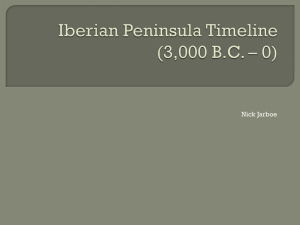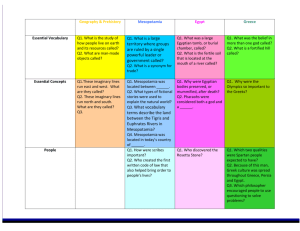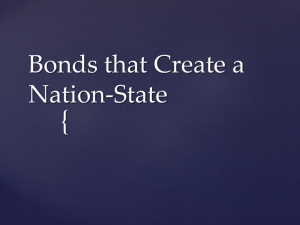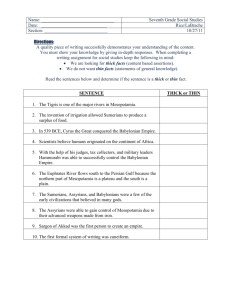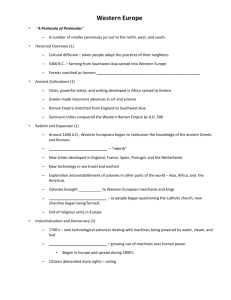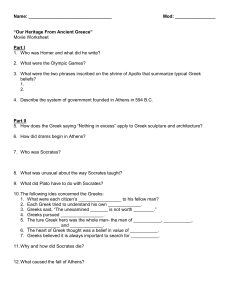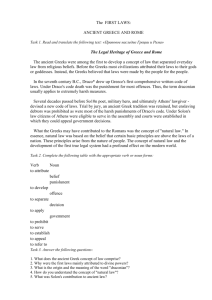History quizzes - Historiasiglo20.org
advertisement
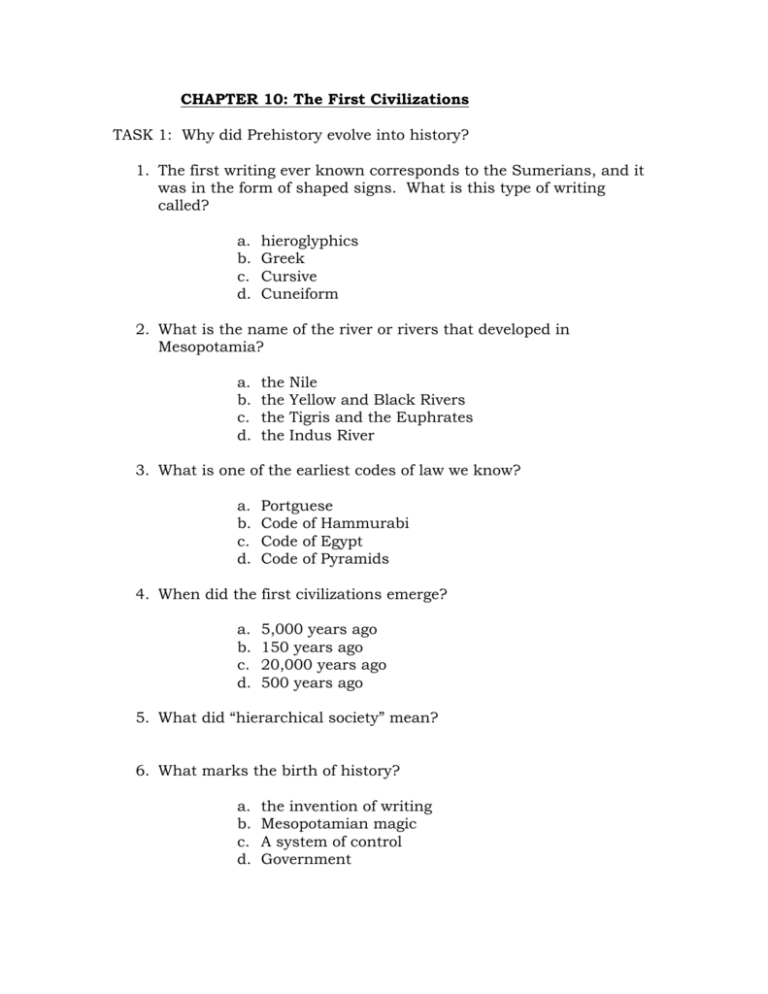
CHAPTER 10: The First Civilizations TASK 1: Why did Prehistory evolve into history? 1. The first writing ever known corresponds to the Sumerians, and it was in the form of shaped signs. What is this type of writing called? a. b. c. d. hieroglyphics Greek Cursive Cuneiform 2. What is the name of the river or rivers that developed in Mesopotamia? a. b. c. d. the the the the Nile Yellow and Black Rivers Tigris and the Euphrates Indus River 3. What is one of the earliest codes of law we know? a. b. c. d. Portguese Code of Hammurabi Code of Egypt Code of Pyramids 4. When did the first civilizations emerge? a. b. c. d. 5,000 years ago 150 years ago 20,000 years ago 500 years ago 5. What did “hierarchical society” mean? 6. What marks the birth of history? a. b. c. d. the invention of writing Mesopotamian magic A system of control Government TASK 2: How did the first empires emerge? 1. The construction of irrigation _____________________ allowed for remarkable developments to take place. 2 Fill in the social pyramid diagram appropriately with the following terms: King Empire Slaves/citizens Civil servants Governors 3 Which two buildings stood out in Mesopotamia? a. walls b. palace c. temple TASK 3: What was society like in the first civilizations? 1. What is the name of the civil servant who specialized in registering laws in writing and commercial transactions? i. ii. iii. iv. a lawyer a priest a scribe the aristocracy 2. Schools in Mesopotamia were for everyone, including women and poor people. True False 3. Explain what barter system means, and give an example. 4. Women were the property of men and when they worked, they made more money than men True False TASK 4 What was culture like in Mesopotamia? 1.What does polytheistic mean? v. vi. vii. viii. that people went shopping a lot for shoes the idea that there is only one God the idea that there are many Gods that the Gods would get mad at you and turn you into a small animal 2.The _______________ were in charge of religious rituals. 3.Aristocracy refers to: ix. x. xi. xii. peasants craftsmen geniuses who created new ways of thinking the king, his family and the nobility 4. The first schools in the history of humanity were found in Mesopotamia. True False 5. In architecture, the materials used for construction were __________ and _______________. Chapter 12: Ancient Greece TASK 1: What territories did the Greek world consist of? 1. What are the Olympics? Describe the events, and how often they took place. 2. Where was Ancient Greece located? South Asia, near where India is today a. Eastern peninsula of Africa, and the Islas Canarias b. Southern area of the Balkan peninsula and some islands c. Northern Europe, near Denmark and the Mediterranean 3.The ancient Greeks lived in small in independent cities, where each had its own government, laws, and army, and this is why they called city-states or polis True False 4. Why was it difficult to communicate by land? a. b. c. d. Because Because Because Because they didn’t have cars they wanted to trade only by water instead there were lots of mountains there were too many people 5. A part of the population was forced to emigrate. Small groups of people went across the Mediterranean and founded _______________. 6.Alexander the Great conquered land as far as the ________________, in India TASK 2: What was the history of the Greeks? 1 2 B.C. 3 0 A.D. On the timeline above, label each main age of ancient Greece – the Archaic Age, the Classical Age, and the Hellenistic Age. Give at least one characteristic of each age. 2.Who was Herodotus, and why was he important? Task 3: Why was Athens the main polis? 1. Which of the following was NOT a development of ancient Greece? a. b. c. d. democracy theater philosophy technology 2.What does ‘democracy’ mean? How does it operate? 3.The Athenians attached great importance to education. true false 4.What was the political system of Athens? a. b. c. d. populism democracy republic communism Task 4: Who did the Greeks fight against? 1.The Persian War is different from the Peloponnesian War because it is not a civil war. True false 2. The Persian Wars took place because: a. b. c. d. the the the the Greeks Greeks Greeks Greeks rebelled rebelled rebelled rebelled against against against against the Athenians the Armenians the Persians Peloponnesus 3.The intervention of the Athenian soldiers, called ____________, was very important in winning these wars. 4.The governance and society of Sparta was very different from Athens. Describe how they were different. 5.The Peloponnesian War was: a. b. c. d. a a a a civil civil civil civil war war war war between between between between Athens and Peloponnesus the soldiers and the citizens races Athens and Sparta 6.Eventually, Athens lost the war, and the Greek city-states were weakened. True false Chapter 14: The Roman Empire TASK 1: What do we call the Roman Empire? 2. An empire is: a. b. c. d. a type of dress a monarchy a lot of land ruled by animals an extensive territory under the same government 3. The River ___________ forms a meander near its mouth, around ______________. 4. The __________, a people from the centre of Italy, conquered the seven hills in the 7th century and turned the small villages into a city : ______________. 5. The Etruscans did not form a single state; they were a collection of autonomous cities ruled by kings. True False 6. During the period of Etruscan influence, Rome was a ________ ruled by a king assisted by a Senate. 7. The Romans threw out the Etruscan monarchs and established the republic. True False TASK 2: What happened during the monarchy and the republic? 1. In the beginning, Rome was ruled by _______________. 2. When the Romans threw out the _________________, they established a ______________. 3. Define this word: comitia. 4. Who were the patricians? What did they do? 5. The plebeians were the: a. b. c. d. the workers for the entire city people who always had the right to vote the ones who never struggled the immigrants and foreigners that were the largest group 6. Slaves were prisoners of war or sons of kings and queens. True False TASK 4: What was life like during the empire? 1. The peace of the empire was guaranteed by: a. b. c. d. wars all the time a professional army football players women and children 2.The emperor was the head of the army True False 3. The most expensive products arrived at the ports of all of the following cities EXCEPT: a. b. c. d. Alexandria Antioch Bilbao Byzantium 4.When did the most art and literature take place? In wartime or at peace? 5. What is the difference between citizens and patricians? 6. Roman women could not take part in political life, but had other rights such as owning property, run businesses, and participate in activities and parties. True False TASK 5: Why did the Roman Empire go into crisis? 1. What people applied pressure from the north? Why were they called barbarians? 2. Who applied pressure from the east? 3. Taxes increased because: a. Everyone was spending money b. Military expenses were high c. They had to protect themselves from the women d. People kept moving away 4. What does “ruralization” mean? 5. What did the emperor Constantine do that other emperors did not do? a. b. c. d. tolerated Christianity so as to unify his people internally divided the empire into different sections pushed all the foreign people out of the country sailed on his boat all the time 6. The Huns were commanded by a man named ________________ Chapter 16: The Iberian Peninsula TASK 1: Who were the Iberians and the Celts? 1. The Iberians lived near rivers in high areas so they could: a. b. c. d. have lots of water protect themselves better get away from foreigners so they could live by waterfalls 2. The economy was based on agriculture, and the most important crops were: 3. ______________ gained importance because they were lots of silver and gold deposits in their territory. 4. How were the Iberians socially organized? Who was the regulus, and was everyone considered equally? 5. The Celts lived in castros, which were: a. b. c. d. cities made of gold types of houses high, walled villages circular rooms 6. Name a few things the Celts worshipped. 7. In what way were the funeral practices of the Celts and Iberians similar? 8. The Iberian economy was based on architecture. True False 9. The Celtic economy was mainly pastoral. What does “pastoral” mean? TASK 2: What peoples colonized the Iberian peninsula? 1. Tartessos was the oldest kingdom of the Iberian Peninsula. True False 2. It was settled in _________ Valley and its influence stretched all over Andalucia and ______________. 3. The Phoenicians, were excellent: a. b. c. d. seafarers, ship builders and craftsmen merchants, ship builders, and seafarers fishermen warriors and merchants 4. The Phoenicians acted as “trade intermediaries” between countries. Explain what this means. 5. The arrival of Greeks in the Iberian Peninsula is mainly for trade reasons. What were the products that most interested the Greeks? a. b. c. d. metals, salt and diamonds sand, salt and diamonds metals, salt, and esparto cheese, milk, and grapes 6. What is a sarcophagus? 7. The __________ came after the Phoenicians and extended their reign over colonies like Ibiza and Cartagena. 8. What was the language of ancient Rome that reached the whole known world?
